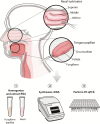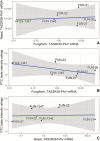Tissue-Dependent Expression of Bitter Receptor TAS2R38 mRNA
- PMID: 30351347
- PMCID: PMC6295798
- DOI: 10.1093/chemse/bjy066
Tissue-Dependent Expression of Bitter Receptor TAS2R38 mRNA
Abstract
TAS2R38 is a human bitter receptor gene with a common but inactive allele; people homozygous for the inactive form cannot perceive low concentrations of certain bitter compounds. The frequency of the inactive and active forms of this receptor is nearly equal in many human populations, and heterozygotes with 1 copy of the active form and 1 copy of the inactive form have the most common diplotype. However, even though they have the same genotype, heterozygotes differ markedly in their perception of bitterness, perhaps in part because of differences in TAS2R38 mRNA expression. Other tissues express this receptor too, including the nasal sinuses, where it contributes to pathogen defense. We, therefore, wondered whether heterozygous people had a similar wide range of TAS2R38 mRNA in sinonasal tissue and whether those with higher TAS2R38 mRNA expression in taste tissue were similarly high expressers in nasal tissue. To that end, we measured gene expression by quantitative PCR in taste and sinonasal tissue and found that expression abundance in one tissue was not related to the other. We confirmed the independence of expression in other tissue pairs expressing TAS2R38 mRNA, such as pancreas and small intestine, using autopsy data from the Genotype-Tissue Expression project (although people with high expression of TAS2R38 mRNA in colon also tended to have higher expression in the small intestine). Thus, taste tissue TAS2R38 mRNA expression among heterozygotes is unlikely to predict expression in other tissues, perhaps reflecting tissue-dependent function, and hence regulation, of this protein.
Figures




References
-
- Adappa ND, Howland TJ, Palmer JN, Kennedy DW, Doghramji L, Lysenko A, Reed DR, Lee RJ, Cohen NA.. 2013. Genetics of the taste receptor T2R38 correlates with chronic rhinosinusitis necessitating surgical intervention. Int Forum Allergy Rhinol. 3:184–187. - PubMed
-
- Adler E, Hoon MA, Mueller KL, Chandrashekar J, Ryba NJ, Zuker CS.. 2000. A novel family of mammalian taste receptors. Cell. 100:693–702. - PubMed
Publication types
MeSH terms
Substances
Grants and funding
LinkOut - more resources
Full Text Sources

